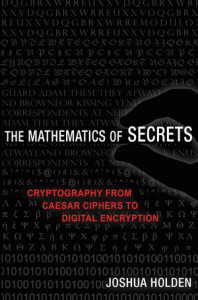 Ten days ago we posted a cryptogram puzzle, set by mathematician and author Josh Holden. We’ve had a number of entries, some which were so enthusiastic they ignored that we’d said to email them in and tried to post in the comments. However, from the correctly submitted entries, we had one stand-out winner – a quick reply, with a detailed description of the solution and a worthy recipient of a copy of The Mathematics of Secrets. Here’s Josh’s explanation of the puzzle, for anyone who hasn’t cracked it yet.
Ten days ago we posted a cryptogram puzzle, set by mathematician and author Josh Holden. We’ve had a number of entries, some which were so enthusiastic they ignored that we’d said to email them in and tried to post in the comments. However, from the correctly submitted entries, we had one stand-out winner – a quick reply, with a detailed description of the solution and a worthy recipient of a copy of The Mathematics of Secrets. Here’s Josh’s explanation of the puzzle, for anyone who hasn’t cracked it yet.
You're reading: Posts By Joshua Holden
Competition: Cryptogram Puzzle
 Author and mathematician Josh Holden has come up with a nice puzzle — so we’re posting it as a competition. If you think you can decrypt the message below, send in the decrypted message and a one- or two-sentence description of the mathematical principle behind the encryption key to root@aperiodical.com. The first correct entry received will win a copy of Josh’s book, The Mathematics of Secrets.
Author and mathematician Josh Holden has come up with a nice puzzle — so we’re posting it as a competition. If you think you can decrypt the message below, send in the decrypted message and a one- or two-sentence description of the mathematical principle behind the encryption key to root@aperiodical.com. The first correct entry received will win a copy of Josh’s book, The Mathematics of Secrets.
The technical name for the “cryptograms” found in many newspapers and magazines is monoalphabetic monographic substitution ciphers — monographic meaning that they make substitutions one letter at a time and monoalphabetic meaning that the substitution rule is the same every time a given letter appears in the message.
Most often the easiest way to start solving these is to look at one-letter words which are usually “I” or “a”, then two-letter words, etc. If the breaks between the words are removed, then you might use the fact that in a typical English text the letter “e” will occur about 13% of the time, followed by “t” and “a” at 7-8% and others farther behind.
What then should we make of the following cryptogram?
YOFQX RGLQT GCQPB FFGQJ IQOFT SYVQH FSFQV FTYFC QJGQY OFRSQ YOSJG FQHOF GQYOF NQTSS REFCQ HRYOQ TQLSF TYQZS JHCQT VVFDW AFCQT WJBYQ YOFDQ TAAQV JSYVQ JIQAR YYAFQ WRSCV QTGCQ WFTVY VQTVQ HFAAQ TVQYO FQHOJ AFQMT ZXQJI QZTSC VQYOF QXGTE FQHTV QVYTG CRGLQ WFIJS FQYOF DQRGQ ZOTRG VQHRY OQTQV JACRF SQJGQ FTZOQ VRCFQ YJQLB TSCQO RDQTG CQGFT SQYOF QXRGL QHTVQ YOFQH ORYFQ STWWR YQHRY OQTQY SBDMF YQRGQ JGFQO TGCQT GCQTQ VZSJA AQJIQ MTSZO DFGYQ RGQYO FQJYO FS
The letter “Q” appears almost 20% of the time, followed by “F” at about 10%, and “Y” and “T” at about 8%. The original text is English (in fact it’s from a famous work of children’s literature) and it doesn’t have a particularly odd distribution of letters. Can you decrypt the message? For bonus points, can you figure out what is mathematically interesting about the encryption key?
“Pariah Moonshine” Part III: Pariah Groups, Prime Factorizations, and Points on Elliptic Curves
In Part I of this series of posts, I introduced the sporadic groups, finite groups of symmetries which aren’t the symmetries of any obvious categories of shapes. The sporadic groups in turn are classified into the Happy Family, headed by the Monster group, and the Pariahs. In Part II, I discussed Monstrous Moonshine, the connection between the Monster group and a type of function called a modular form. This in turn ties the Monster group, and with it the Happy Family, to elliptic curves, Fermat’s Last Theorem, and string theory, among other things. But until 2017, the Pariah groups remained stubbornly outside these connections.
“Pariah Moonshine” Part II: For Whom the Moon Shines
This post is part of a series of posts by guest author Joshua Holden.
I ended Part I with the observation that the Monster group was connected with the symmetries of a group sitting in 196883-dimensional space, whereas the number 196884 appeared as part of a function used in number theory, the study of the properties of whole numbers. In particular, a mathematician named John McKay noticed the number as one of the coefficients of a modular form.
“Pariah Moonshine” Part I: The Happy Family and the Pariah Groups
Being a mathematician, I often get asked if I’m good at calculating tips. I’m not. In fact, mathematicians study lots of other things besides numbers. As most people know, if they stop to think about it, one of the other things mathematicians study is shapes. Some of us are especially interested in the symmetries of those shapes, and a few of us are interested in both numbers and symmetries.